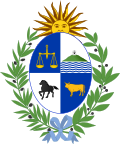Italy–Uruguay relations
 | |
Italy |
Uruguay |
|---|---|
Italy–Uruguay relations are the current and historical relations between Italy and Uruguay. Both nations enjoy warm and friendly relations, the importance of which centers on the history of Italian migration to Uruguay. Since 40% of the Uruguayan population is of Italian descent, relations between both nations have remained close, both politically and culturally.[1]
History
[edit]In 1834, the Kingdom of Sardinia opened a consular agency in Montevideo and was followed by the Grand Duchy of Tuscany and the Papal States.[2] Italian General Giuseppe Garibaldi—a key figure in the Italian unification (Risorgimento) and the creation of the Kingdom of Italy—played a prominent role in the Uruguayan Civil War, fighting in support of the Gobierno de la Defensa.[3]

In the 1850s, a significant wave of Italian immigration began in Uruguay, becoming the backbone of Uruguayan culture.[4] The Italian-Uruguayan community became the largest among immigrant groups, and by 1908, 34.3% of all foreign residents in Uruguay were of Italian origin.[5] In 1920, there were twenty-six Italian associations in Montevideo, including the Italian Hospital Umberto I, the Italian Bank of Uruguay, as well as various educational institutions.[6]
In 1924, Umberto of Savoy —then Prince of Piedmont and future King Umberto II— visited Uruguay as part of a political strategy promoted by Fascist Italy under Benito Mussolini, aimed at strengthening ties between Italian emigrants and their homeland.[7] The Italian legation in Montevideo undertook efforts to influence local politics and promote fascism among descendants of Italians in the country, primarily through the establishment of social and cultural associations.[8] The Italian envoy to Uruguay, Serafino Mazzolini, stated that Mussolini regarded Uruguay as the most 'Italian' country in the Americas, owing to its significant population of Italian descent.[9]
During Gabriel Terra’s rule (1931–1938), Uruguay developed closer ties with Fascist Italy, mainly driven by the traditionalist and corporatist elements of Terra’s Revolución Marzista (Spanish for 'March Revolution').[10] During the Second Italo-Ethiopian War, the Uruguayan government did not condemn Italy’s invasion, and a contingent of Uruguayan volunteers traveled to fight alongside Italian forces.[11]
In January 1942, during World War II, Uruguay declared war on the Axis powers (which included Italy).[12] In April 1946, both nations restored diplomatic relations, and in 1952 they signed an immigration agreement aimed at “increasing and regulating” migration, taking into account Uruguay’s demand for workers and the labor supply available in Italy.[13]
There have been several high-level visits between leaders of both nations. In October 2005, Uruguayan President Tabaré Vázquez paid a visit to Italy.[14] In March 2017, Italian President Sergio Mattarella paid a visit to Uruguay.[15]
In 2019, 125,000 Uruguayans (approximately 3,5% of the country's total population) held Italian passports, many being dual Italian and Uruguayan citizens.[16]
Bilateral agreements
[edit]Both nations have signed several agreements such as a Treaty of Friendship, Commerce and Navigation (1843); Extradition Treaty (1881); Agreement on the Transportation of Cattle between both nations (1976); Agreement on Social Security (1985); Agreement on Technical Cooperation (1988); Agreement on the Promotion and Protection of Investments (1990); Agreement on Cinematographic Co-Production (2004); Agreement on Defense Cooperation (2017); Agreement in Judicial Matters (2019); Agreement to Eliminate Double Taxation in Relation to Income Taxes and Prevent Tax Evasion and Avoidance (2019) and an Agreement on Cultural and Scientific cooperation (2019).[17]
Resident diplomatic missions
[edit]- Italy has an embassy in Montevideo.[18]
- Uruguay has an embassy in Rome and a consulate-general in Milan.
-
Embassy of Italy in Montevideo
-
Embassy of Uruguay in Rome
See also
[edit]References
[edit]- ^ Felipe Arocena. "How Immigrants Have Shapped [sic] Uruguay". Culturales. 5 (9). ISSN 2448-539X.
- ^ Ministero degli Affari Esteri e della Cooperazione Internazionale. "Ambasciata d'Italia Montevideo". ambmontevideo.esteri.it (in European Spanish). Archived from the original on 2025-02-13. Retrieved 2025-08-02.
- ^ Scirocco, Alfonso (2007). Garibaldi: Citizen of the World. Translated by Cameron, Allan. Princeton University Press. pp. 82–124. ISBN 9780691115405. Retrieved 23 June 2024.
- ^ Beretta Curi, Alcides (2014). Inmigración europea e industria: Uruguay en la región (1870-1915). Montevideo: Comisión Sectorial de Investigación Científica - Universidad de la República. ISBN 978-9974-0-1081-9.
- ^ Murillo García, Julio Cesar; Gutiérrez Morales, Guillermo; Gallego, Elizabeth (2024-06-30). "La imagen territorial como síntesis identitaria de la mujer emberá chamí, residentes en el departamento de Risaralda, Colombia". Scripta Nova. Revista Electrónica de Geografía y Ciencias Sociales. 28 (2). doi:10.1344/sn2024.28.43359. ISSN 1138-9788.
- ^ "Hospital Italiano Umberto 1º. | Municipio CH". municipioch.montevideo.gub.uy. Archived from the original on 2024-06-22. Retrieved 2025-08-02.
- ^ "Las dificultades para acceder al pasaporte italiano tras los cambios en la normativa del país europeo". Radio Sarandí 690 AM (in Spanish). 2025-05-22. Retrieved 2025-08-02.
- ^ Giannattasio, Valerio (2022). "Vínculos diplomáticos entre la Italia de Mussolini y Uruguay". Historia de los conservadores y las derechas en Uruguay: De la contrarrevolución a la Segunda Guerra Mundia (in Spanish). Montevideo: Banda Oriental. pp. 213–227. ISBN 9789974112612.
- ^ Rossi, Gianni (2005). Mussolini e il diplomatico: la vita e i diari di Serafino Mazzolini (in Italian). Soveria Mannelli: Rubbettino Editore. pp. 85-92. ISBN 9788849812084.
- ^ administrador. "Nazismo en el Río de la Plata (1933-1945)". Centro Recordatorio del Holocausto de Uruguay (in Spanish). Retrieved 2025-08-02.
- ^ Rodríguez Ayçaguer, Ana María (2009). Un pequeño lugar bajo el sol: Mussolini, la conquista de Etiopía y la diplomacia uruguaya, 1935-1938 (in Spanish). Montevideo: Banda Oriental. p. 28. ISBN 9789974105799.
- ^ Italia-Uruguay (in Spanish)
- ^ Adamo, Gianfranco (1999). Facetas históricas de la emigración italiana al Uruguay (in Spanish).
- ^ Visite in Italia (in Italian)
- ^ Visita de Estado del Señor Presidente de la República Italiana en Uruguay (in Spanish)
- ^ Italia sigue mejorando los servicios que brinda a sus ciudadanos en Uruguay (in Spanish)
- ^ Acuerdos internacionales del Uruguay: Italia (in Spanish)
- ^ Embassy of Italy in Montevideo




